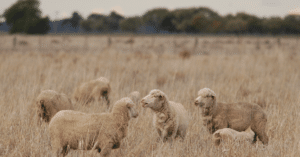Looking at lamb and mutton export values can help provide some explanation about why lamb and mutton prices haven’t been able to reach the record highs seen in cattle. Admittedly, the data is three months old, so doesn’t provide direct real time insight, but recent lamb price trends are suggestive that it’s unlikely that the export value situation has changed significantly in the past few months.
Meat and Livestock Australia’s (MLA) database is very handy for pulling out all sorts of information, with red meat export values being of particular interest to livestock producers.
Looking at the value of lamb and mutton exports, relative to the amount of lamb and mutton exported, gives us an indication of how much per kilo our export markets are willing to pay. Comparing the dollars per kilo export value to livestock prices gives a very broad idea of export processor margins.
For figure 1 we have split lamb export values into our two major markets, the US and China. Not surprisingly the US export values per kilo is higher, with more higher value cuts heading that way. China imports lower value cuts, but interestingly since 2018, the Eastern States Trade Lamb Indicator (ESTLI) has followed Chinese export values very closely.
Despite a general feeling that export demand has returned, we can see in figure 1 that the dollar per kilo return for lamb has been lower this year. In the first quarter of 2021, the average export value to the US was down 8.6%. Export values to China were down 9.7%, this simply means less money was coming in to processors.
We have seen mutton prices remain relatively strong in saleyards, and export values give a bit of an indication of why. Figure 2 shows mutton export values have fallen in dollar per kilo, but not as much as lamb. Total mutton export values for the first quarter were down 3.2% on 2020, to average 772ȼ/kg swt.
Lamb export values to China were actually cheaper than the average mutton value in the first quarter, at 769ȼ. It’s little wonder there have been comments from the yards that mutton is making as much as lamb in many cases.
What does it mean?
Figure 3 is messy, but it essentially shows the discount in saleyards to export values in cents per kilo. In the first quarter, both lamb and mutton saleyard prices were at the top of their eight-year range relative to their export values.
Strong saleyard prices relative to export values aren’t great for further price rises. Obviously, we don’t know what export values have done since March, but price trends in the face of dwindling supply suggest things are still pretty tight for export processors.
Have any questions or comments?
Key Points
- Lamb and mutton export values have fallen since the pre-covid records in early 2020.
- Lower export values have limited the upside for lamb and mutton in saleyards.
- Improved export values are required to see higher lamb or mutton values.
Click on figure to expand
Data sources: MLA, DAWE, Mecardo















